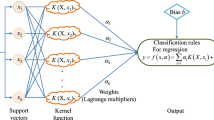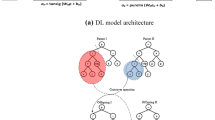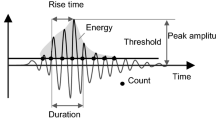Abstract
Due to its inert nature, concrete has good fire resistance properties. As such, concrete has often been favored for construction – especially where fire hazard is expected. However, this does not mean that reinforced concrete cannot catch fire. It can still be affected by heat and, if exposed to high temperatures, can eventually break down. Therefore, the fire resistance of the reinforced concrete (RC) columns is a critical concern. There are many ways for assessing the fire resistance of structures, but it is difficult to quantify the fire resistance in quantitative terms. The purpose of this work is to investigate the use of unsupervised machine learning by means of clustering to examine the fire resistance of RC columns. A database of over 144 RC columns subjected to standard fire conditions has been collected and then examined via the interpretable Fuzzy C-Means algorithm (FCM) and the Classification and Regression Tree (CART) model. Our results indicate that this clustering technique groups RC columns into four natural groups – each with specific properties and characteristics. Moreover, the CART model is used to analyze the variables used as the basis for the clustering of RC columns. Accordingly, when RC columns are separated into four natural clusters, the first split occurs due to restrictions, and the second separation is controlled by the compressive strength and reinforcement ratios of the columns. This research might be the first to attempt to leverage clustering analysis to investigate the fire response of RC columns. The findings of the study clearly show that unsupervised machine learning can provide valuable insights to fire engineers often missing from traditional supervised learning.
Access this chapter
Tax calculation will be finalised at checkout
Purchases are for personal use only
Similar content being viewed by others
References
Bažant, Z.P., Kaplan, M.F., Bazant, Z.P.: Concrete at High Temperatures: Material Properties and Mathematical Models (1996)
Bezdek, J.: Pattern Recognition With Fuzzy Objective Function Algorithms (1981)
Buttignol, T.E.T., Bittencourt, T.N.: Simplified design procedures for the structural analysis of reinforced concrete columns in fire. Eng. Struct. 246, 113076 (2021)
Dogan, E.: Solving design optimization problems via hunting search algorithm with levy flights. Struct. Eng. Mech. 52(2) (2014)
Dunn, J.C.: A Fuzzy Relative of the ISODATA Process and Its Use in Detecting Compact Well-Separated Clusters (1973)
Erdal, F., Dogan, E., Saka, M.P.: Optimum design of cellular beams using harmony search and particle swarm optimizers. J. Constr. Steel Res. 67(2), 237–247 (2011)
Gedam, B.A.: Fire resistance design method for reinforced concrete beams to evaluate fire-resistance rating. Structures. 33, 855–877 (2021)
Ghoreishi, M., Mirzazadeh, A., Weber, G.-W.: Optimal pricing and ordering policy for non-instantaneous deteriorating items under inflation and customer returns. Optimization 63(12), 1785–1804 (2014)
Harmathy, T.Z.: Effect of mositure on the fire endurance of building elements. ASTM Spec. Tech. Publ. (1965)
Hasançebi, O., Dogan, E.: Evaluation of topological forms for weight-effective optimum design of single-span steel truss bridges. Asian J. Civ. Eng. 12, 431–448 (2011)
Hertz, K.D.D.: Limits of spalling of fire-exposed concrete. Fire Saf. J. 38(2), 103–116 (2003)
Hotelling, H.: The most predictable criterion. J. Educ. Psychol. (1935)
Khalilpourazari, S., Khalilpourazary, S., Özyüksel Çiftçioğlu, A., Weber, G.-W.: Designing energy-efficient high-precision multi-pass turning processes via robust optimization and artificial intelligence. J. Intell. Manuf. 32(6), 1621–1647 (2020)
Khalilpourazari, S., Mirzazadeh, A., Weber, G.-W., Pasandideh, S.H.R.: A robust fuzzy approach for constrained multi-product economic production quantity with imperfect items and rework process. Optimization 69(1), 63–90 (2020)
Khalilpourazari, S., Pasandideh, S.H.R.: Modeling and optimization of multi-item multi-constrained EOQ model for growing items. Knowledge-Based Syst. 164, 150–162 (2019)
Klingsch, E.W.H.: Explosive spalling of concrete in fire. Tese doutorado (2014)
Kodur, V., Cheng, F., Wang, T., Latour, J., Leroux, P.: Fire Resistance of High-Performance Concrete Columns (2001)
Kodur, V., McGrath, R., Leroux, P., Latour, J.: Experimental Studies for Evaluating the Fire Endurance of High-Strength Concrete Columns (2005)
Kodur, V.K., Naser, M.Z.: Structural Fire Engineering. McGraw Hill Professional (2022)
Kodur, V.R., Mcgrath, R.C., Latour, J.C., Maclaurin, J.W.: Experimental Studies for Evaluating the Fire Endurance of High- Strength Concrete Columns (2000)
Kouka, N., Fdhila, R., Hussain, A., Alimi, A.M.: Dynamic multi objective particle swarm optimization with cooperative agents. In: 2020 IEEE Congress on Evolutionary Computation (CEC), pp. 1–8 (2020)
Liu, J.-C.C., Tan, K.H., Yao, Y.: A new perspective on nature of fire-induced spalling in concrete. Constr. Build. Mater. 184, 581–590 (2018)
Naser, M.Z.: Heuristic machine cognition to predict fire-induced spalling and fire resistance of concrete structures. Autom. Constr. 106, 102916 (2019)
Noman, M., Yaqub, M., Fahad, M., Butt, F., Khalid, B.: Dynamic characteristics of RC structures in short and long duration real fires. Case Stud. Constr. Mater. 16, e01058 (2022)
Packialakshmi, S., Krishnakumar, Erskine, S., Anuradha, B.: Performance evaluation of fire resistant characteristics in polypropylene fiber concrete. Mater. Today Proc. (2021)
Pearson, K.: On lines and planes of closest fit to systems of points in space. London, Edinburgh, Dublin Philos. Mag. J. Sci. 2(11), 559–572 (1901)
Phan, L.T., Carino, N.J.: Fire performance of high strength concrete: research needs. In: Advanced Technology in Structural Engineering, pp. 1–8. American Society of Civil Engineers, Reston, VA (2000)
Qin, D., Gao, P., Aslam, F., Sufian, M., Alabduljabbar, H.: A comprehensive review on fire damage assessment of reinforced concrete structures. Case Stud. Constr. Mater. e00843 (2021)
Rather, S.A., Bala, P.S.: Analysis of gravitation-based optimization algorithms for clustering and classification. IGI Global (2020)
Raut, N., Kodur, V.: Response of Reinforced Concrete Columns Under Fire-Induced Biaxial Bending (2011)
Rousseeuw, P.J.: Silhouettes: A graphical aid to the interpretation and validation of cluster analysis. J. Comput. Appl. Math. (1987)
Seitlllari, A., Naser, M.Z.: Leveraging artificial intelligence to assess explosive spalling in fire-exposed RC columns. Comput. Concr. (2019)
Shah, A.H., Sharma, U.K.: Fire resistance and spalling performance of confined concrete columns. Constr. Build. Mater. 156, 161–174 (2017)
Song, T.-Y., Han, L.-H., Tao, Z.: Structural behavior of SRC beam-to-column joints subjected to simulated fire including cooling phase. J. Struct. Eng. (2015)
Tirkolaee, E.B., Mardani, A., Dashtian, Z., Soltani, M., Weber, G.W.: A novel hybrid method using fuzzy decision making and multi-objective programming for sustainable-reliable supplier selection in two-echelon supply chain design. J. Clean. Prod. 250, 119517 (2020)
Ulm, F.-J., Coussy, O., Bažant, Z.P.: The “Chunnel” Fire. I: Chemoplastic softening in rapidly heated concrete. J. Eng. Mech. 125(3), 272–282 (1999)
Wenwen, C., Jihong, Y.: The most adverse fire scenario research of steel frame structure fire-resistant design based on structural vulnerability analysis. Structures 34, 2861–2875 (2021)
Wu, Y., Xu, Y., Shi, Y., Ban, H.: Overall buckling behavior of fire-resistant steel welded I-section columns under ambient temperature. J. Constr. Steel Res. 157, 32–45 (2019)
Author information
Authors and Affiliations
Corresponding author
Editor information
Editors and Affiliations
Rights and permissions
Copyright information
© 2023 The Author(s), under exclusive license to Springer Nature Switzerland AG
About this paper
Cite this paper
Çiftçioğlu, A.Ö., Naser, M.Z. (2023). Unsupervised Machine Learning for Fire Resistance Analysis. In: Mirzazadeh, A., Erdebilli, B., Babaee Tirkolaee, E., Weber, GW., Kar, A.K. (eds) Science, Engineering Management and Information Technology. SEMIT 2022. Communications in Computer and Information Science, vol 1808. Springer, Cham. https://doi.org/10.1007/978-3-031-40395-8_15
Download citation
DOI: https://doi.org/10.1007/978-3-031-40395-8_15
Published:
Publisher Name: Springer, Cham
Print ISBN: 978-3-031-40394-1
Online ISBN: 978-3-031-40395-8
eBook Packages: Computer ScienceComputer Science (R0)




